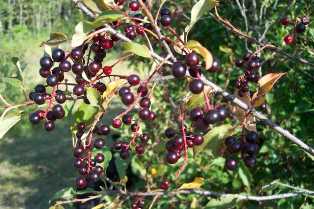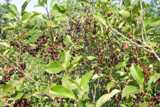Chokecherry Production in Manitoba
- Economics and Marketing
- Economic Considerations
- Site Selection
- Fertilizer
- Weed Control
- Insects
- Diseases
- Pollination
- Irrigation
- Pruning and Renovation
- Harvesting
- Post-Harvest
Description

The chokecherry (Prunus virginiana) or wild black cherry is a medium to large multi-stemmed fruiting shrub (1-7m) or a small tree (9-13m). Like the saskatoon, it is a member of the Rose family and is related to domestic cherries, plums, peaches and apricots. It is native to North America, with a range stretching from the Yukon to New Mexico and from B.C. to Newfoundland.
Uses
Throughout North American history, chokecherries have been a source of food (in soups, stews, pemmican, salmon dishes). The bark and roots of the chokecherry were used by North American natives for their medicinal properties in treating a variety of maladies, and, until 1975, the bark was a recognized pharmaceutical. Chokecherries contain high levels of functional food properties.
Chokecherries today are used most commonly in concentrates, jellies, syrups, sauces, juices, jams, and wine. As a shrub, it is developing popularity in the prairies as part of multi-row shelterbelt, as an ornamental and for use in wildlife habitat improvement plantings.
Economics and Marketing
Chokecherries may be sold for processing, but opportunities for marketing and processing need to be better defined. The chokecherry is considered to have good diversification potential by many fruit growers. Both Europe and Japan appreciate rich dark colours and tart flavours like that of the chokecherry. Some experts believe that commercial chokecherry production has more potential than the saskatoon for large scale production, due to its hardiness and reliable yield.
Currently, the primary source of chokecherries is wild stands where less than 5% are actually harvested. However, as more orchards are planted and the trees begin to produce fruit this should change.
To meet the commercial processor's demand that fruit be delivered in volume and in a semi-processed state, a system should be established including transportation, storage and a central semi-processing plant. Producers need to work together to establish a regional berry association that will entitle them access to government funding for research and development of a viable chokecherry industry or utilize the resources of the PFGA to reach the same goals.
There are some commercial processors in the prairies willing to buy chokecherry fruit. The demand for fruit is currently greater than can be supplied.
Economic Considerations
Chokecherries do not begin producing until their third or fourth year so fruit production is a long-term commitment. Yield gradually increases after the fourth year. At maturity, yield is estimated at 15,000 lb of fruit per acre or higher and yield appears fairly consistent eight to nine years out of 10.
Early orchards were difficult to establish because of limited plant material and a lack of different cultivars. As interest grows in this crop, nurseries are making larger quantities of plants available and offering a larger selection of chokecherry cultivars. This has also resulted in a decrease in the price of the plants.
As with any other small fruit operation, it is important to consider the distance to large population bases for a market as well as for labour. The chokecherry is abundant in native stands and consistent in its yield, so it is likely that U-Pick for the fresh product would not be in high demand.
The long-term economic feasibility of chokecherry production is yet to be determined. We know that chokecherries have the potential to offer the consistent supply important to a processor. A processor may lower prices if yields are high when a producer's fruit is ready. The berries must be competitively priced so that processors don't go to other provinces where the fruit may be cheaper.
Site Selection
Chokecherries have low susceptibility to weather variability. Proper site selection and good management practices are still important, however, research projects on management practices need to be initiated as insufficient information exists at this time.
Chokecherries grow in a wide variety of soil types and climatic conditions. They thrive in full sun and well-drained soils containing significant amounts of organic matter, and grow well in pH's ranging from 5-8. Saline and poorly drained soils should be avoided.
A gentle northeast or east slope is preferred for good runoff and quick cold air drainage, and windbreaks help reduce damage from strong prevailing winds.
Spacing
Plants should be spaced three to four feet apart. To accommodate mechanical harvesting, aisles should be at least 16 feet wide. Aisles should run north to south to reduce wind, equalize light distribution and decrease sun scald.
Irrigation
Trickle irrigation is the method of choice as it is the least labour intensive, has a lower water requirement than other systems, reduces incidence of disease and is generally cheaper to use. However, the emitters can clog easily and can not be used for frost protection or crop cooling. Refer to the irrigation section for more information.
Fertilizer
Specific recommendations to fertilize a chokecherry orchard are not currently available. Site selection is important and a well drained, loam soil with adequate levels of fertilizer should provide a good starting point for the orchard. Proper soil testing of the site is advisable and required fertilization should occur prior to planting. Caution is advised with application of fertilizers late in the season as delayed hardening-off may occur. However, supplementary fertilization may be required if nutrient deficiencies occur or if site selection is less than ideal. Research has not yet determined the optimum levels of fertilizer to apply to chokecherries. However, 11-51-0 and 23-23-0 may be used until further recommendations can be made. As with any crop, a soil test will determine the current level of nutrients present and a recommendation for fruit crops can be obtained from the soil testing lab.
Weed Control
Weed control costs significantly less compared to saskatoons and is only done in the first five years of production. Clean cultivation is the most cost-efficient method during an orchard's early years. Later, permanent ground cover, annual crop cover, organic or black plastic mulches and other techniques may be considered. Sod provides a durable surface for large harvesters and prevents erosion.
Insects
Currently, insect pests have not significantly affected yields of wild chokecherry stands, but the establishment of monocultural production may change this. Cherry shoot borer, chokecherry fruit gall midge, chokecherry sawfly, ugly nest caterpillar, fall webworm, forest-tent caterpillar, fruit tree leafroller, chokecherry aphid, and lacebugs are all potential pests of chokecherry. There are no insecticides registered for application on chokecherries at this time, meaning that effective, alternative methods of pest control will need to be developed. Growers should monitor the crop weekly in order to watch for insect problems.
Other pests include birds, rabbits, mice and deer. Animal repellents can be sprayed on the trees in the fall to reduce animal feeding. Bird netting has been used successfully for other fruit crops and would likely be effective for chokecherries to protect the fruit.
Diseases
Diseases found on chokecherries include;
- chokecherry shothole
- powdery mildew
- black knot
- western X-disease
Black knot may be controlled by pruning out infected wood in late winter/early spring, remembering to disinfect tools between cuts with 1:10 bleach or Lysol to water solution. Infected wood should be burned before April 1. Maintaining a 200m distance between an orchard and any wild stands of chokecherries decreases risk of contamination. Plants infected with western X-disease should be removed and burned. No chemical controls are registered for black knot or western X-disease.
Please consult The Guide to Fruit Crop Protection for further information on control practices and chemical recommendations for insects, diseases, and weeds.
Pollination
Chokecherries require insects for pollination, and flies primarily are attracted by the fragrance of the blossoms. It has not been determined whether the use of honey bees will increase yield of chokecherries. Two hives/ha are recommended for other commercial fruit crops and may be sufficient for chokecherries. Rental of hives around blossom time may prove more effective than having a colony present permanently.
Irrigation
Chokecherries benefit from a consistent water supply. In the nursery trade, chokecherries are assured 2.5-5.0 cm/week. This is especially important during spring's vegetative growth and fall fruit bud development. Substantial irrigation or fertilization in late summer and fall can delay the onset of dormancy and result in winter injury.
Pruning and Renovation
Assuming a hedgerow system, the hedge should be maintained at 45 cm (18 inches) wide and three metres (10 feet) high to facilitate harvest. Weaker/diseased wood should be removed annually. Chokecherries seem to produce most abundantly on young wood, but research must be done to determine the effects of pruning (especially of older branches) on yield.
Harvesting
Chokecherries ripen from mid-July to September depending on the individual plant and the local climate. Handpicking is most economical during the first few years, with the use of hand rakes and power vibrators speeding up the process. Mechanical harvesters designed for other bush crops have been used successfully to harvest chokecherries, but are only economical for larger operations. Labour costs are significantly lower for chokecherries than for raspberries. A producer can expect a yield of 30 to 40 lbs of fruit per shrub or 11 200 kg/ha (10,000 lb/acre). The life span of a chokecherry ranges from 20 to 40 years. To maximize the use of a mechanical harvester, cultivars that can be harvested by the same harvester as saskatoons. There are many chokecherry cultivars to choose from, but Garrington would be a good example because it only grows to 2.4m and would fit inside the same harvester used for Smoky which is of similar size. Chokecherries have a wider window of harvest dates and more uniform ripening, and so can be harvested after saskatoons.
Post-harvest
Rapid post-harvest cooling (within two to three hours) is necessary to prevent deterioration of the colour, texture and flavour qualities of the fresh product and increase shelf life; therefore, a nearby cooling facility is required. Completing harvest prior to 11:00 am extends this critical time. If fruit cannot be processed within 24 - 48 hours, it is recommended that it be frozen immediately after harvest.

